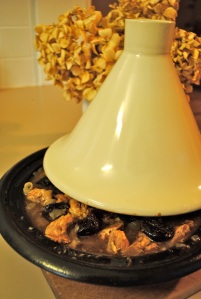I have finally purchased my first tagine, given how much space it takes up in my kitchen cupboard I am hoping to use it often over the cooler months.

Tagine is the Moroccan word that refers to both the conical earthenware vessel and the food prepared in it. The tagine is used for both cooking and serving. The conical shaped lid helps preserve the moisture in the food. The steam condenses on the inside of the lid and drips back into the food and is self basting. This method of cooking is excellent for less expensive cuts of meat which require long slow cooking. The shape also creates circulation of flavours and spices within the food. The lid needs to fit the base correctly to form a complete seal.
There are two types of tagine:
- One is just for serving. These are usually highly coloured and patterned and not suitable for cooking.
- The other type is made from glazed terracotta and require seasoning before use. It can be used on stove top with a diffuser on low heat or in large ovens.
How to season your tagine before use:
- Submerge tagine in water for at least one hour. Remove and dry.
- Rub the inside of the base and lid with olive oil.
- Put tagine in a cold oven and set temperature at 150°C and leave for 2 hours.
- Remove from oven and cool completely.
- Your tagine is now ready to use!
To use your tagine on the stovetop, place it over a low heat with a diffuser over the flame. Layer ingredients in the base and stock or water over them. Cover with the lid and cook for 1-2 hours.
If you’re using it in an oven, preheat the oven to 160°C and position the oven shelf to its lowest position. Make sure you remove the top shelving. Layer ingredients into the base of the tagine, pour stock over the ingredients and cover. Cook in the oven for 1½-2 hours.
Below are two recipes that I will be making in the next month with my new device…
Matt Moran’s Tagine of Lamb with Chick Peas
Serving size: 4
—————
1 kg lamb neck
100 ml vegetable oil
Salt and pepper
2 onions, sliced
6 garlic cloves, whole
3 cinnamon sticks
100g raisins
3 blades mace
3 teaspoons ground cumin
2 teaspoons ground coriander
2 preserved lemon wedges
1 tablespoon harrisa [optional]
100g chick peas, soaked and drained
1 tin tomatoes
————-
250ml chicken stock
250g cous cous
1 tablespoon parsley, chopped
————–
60g yoghurt
1/2 Spanish onion, sliced
1 tablespoon fresh coriander, chopped
To prepare the lamb, cut the lamb necks into even 5cm cubes. Heat 50 ml vegetable oil in a frying pan on a high heat.
Season the lamb pieces with salt, pepper and add to the hot frying pan.
Cook for approximately 3 to 4 minutes until the lamb is brown on all sides.
To prepare the tagine, heat the remaining vegetable oil in a saucepan and when hot, add the onions and garlic.
Cook for approximately for 5 to 10 minutes until the onion just starts to caramelise.
Add in the cinnamon, raisins, mace, ground cumin, coriander, preserved lemon and harrisa. Cook for 1 minute then add in the lamb neck, chick peas and tinned tomatoes.
Stir until combined then transfer the tagine to the slow cooker.
Cook for 3 hours or until the meat is tender.
To prepare the cous cous, bring the chicken stock to boil then pour over the cous cous.
Cover with plastic wrap then leave for 5 minutes.
Stir with a fork to loosen the cous cous, add the chopped parsley and stir until combined then season to taste.
Serve the tagine on a bed of cous cous with yoghurt, sliced Spanish onion and coriander to garnish.
Chicken, preserved lemon, and olive tagine
This chicken tajine recipe is Morocco’s second most popular dish after couscous and considered to be the national dish. Hassan M’Souli’s recipe from Food Safari.
Chermoula Marinade
2 cloves garlic, chopped
1/2 preserved lemon, rinsed and thinly sliced
2 onions, chopped
½ birds eye chilli
1 tbsp sweet paprika
1 tbsp ground cumin
Salt
2 tbsp chopped fresh coriander, stems and leaves
2 tbsp chopped fresh parsley
1/2 teaspoon saffron threads, soaked in a little water
1/2 cup olive oil
2 bay leaves, torn in half
1 whole chicken, size 10 or 12
1 tomato, chopped
1 onion, chopped
2 large potatoes, cut into wedges
1 onion, sliced
1 tomato, sliced
150g pitted green olives
1 bunch fresh coriander, chopped
1 cup water
1 preserved lemon, cut into 6 segments.
Marinade
Process all ingredients together in a food processor until finely chopped and thoroughly combined. Leave for 30 minutes before using. Can be stored in the refrigerator for up to seven days.
Wash and dry the chicken and remove backbone, wing tips and any excess fat. Cut into pieces. Rub all over with ½ of the chermoula marinade and refrigerate overnight or for at least 2 hours.
Combine the tomato and onion with a little more chermoula and spread into the base of the tajine (this will prevent the chicken from burning on the bottom).Arrange chicken pieces in the centre of the tajine on top of tomato mixture. Coat potato wedges with chermoula and arrange around chicken. Top with onion slices, then tomato slices and olives in between the potato wedges.
Mix chopped coriander with remaining chermoula and water. Pour over mixture. Decorate top with preserved lemon wedges.
Cover tajine with lid and cook on a very low gas heat for 45 minutes. Do not stir or lift the lid during the cooking process.
Serve the Tajine directly to the table and impress your guests with a waft of fragrant steam when it’s time to serve with couscous and harissa.
